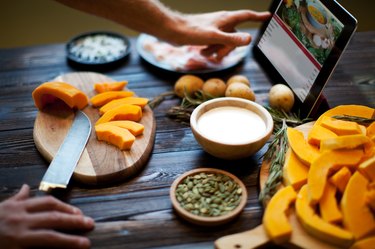
Many of us have grown accustomed to checking nutrition labels to see how much of a certain food constitutes a serving. But when we turn to our own tried-and-true home recipes, we may find ourselves at a bit of a loss. How do we know how many servings the recipe yields, and how many calories are in each?
No worries: You can still whip up your scrumptious from-scratch favorites without tossing out your healthy-eating plan. To sort out the stats on any recipe, you just need to follow four straightforward steps.
Video of the Day
Video of the Day
1. Weigh the Food.
Before you can accurately divide your recipe into servings, you need to know how much it weighs in total.
Weigh the casserole dish or platter the food will be served in before you start cooking. That way, you can subtract the weight of the empty dish from the total to get the weight of the food.
Keep in mind that careful calculations when weighing foods can be especially important for those with certain health conditions, especially diabetes, according to the Diabetes Teaching Center at the University of California, San Francisco.
2. Divide the Recipe into Servings.
Once you know how much the entire finished dish weighs, divide the weight by the number of servings, which is usually listed in the recipe ("serves six," or "serves eight," for example). Round the result to an easy-to-remember number to find the average serving size.
For example, if your lobster mac and cheese weighs 92.86 ounces and yields eight servings, the first number divided by the second would be 11.607, which you would then round to 11.5 ounces per serving. (Divide up the food into individual servings if you don't want to use the food scale every time you'd like a helping.)
3. Calculate Calories.
If your grandma's famous tuna casserole recipe does not tell you how many servings it yields, you will need to determine this yourself. One way to do this is by using a calorie counter. (Also, the calorie content of many ingredients and individual foods can be found in the USDA National Nutrient Database.) Add the calories from each ingredient to find the dish's total calorie count. The Tufts University Human Research Nutrition Center on Aging cautions against forgetting often overlooked ingredients used in cooking, like broth, butter or oil, which could boost the calorie count considerably.
Next, you can decide how many calories you want in each serving. For example, if you'd like to keep each serving to 250 calories, divide the calories in the recipe by 250. Round the resulting number to make a whole number for how many servings the recipe yields. If the recipe has 1,289 calories, divide it by 250 to equal 5.15, round that down to five, and you have the number of servings in the recipe.
Read more: Why Portion Control Works — and How to Get it Right
4. Save the Information.
Calculating serving size information for a recipe takes a bit of time and trouble, so you'll want to save your calculations for every go-to recipe in your arsenal. That way, you will have it on hand when you make it again. All you have to do the next time around is weigh individual servings according to the predetermined weight.